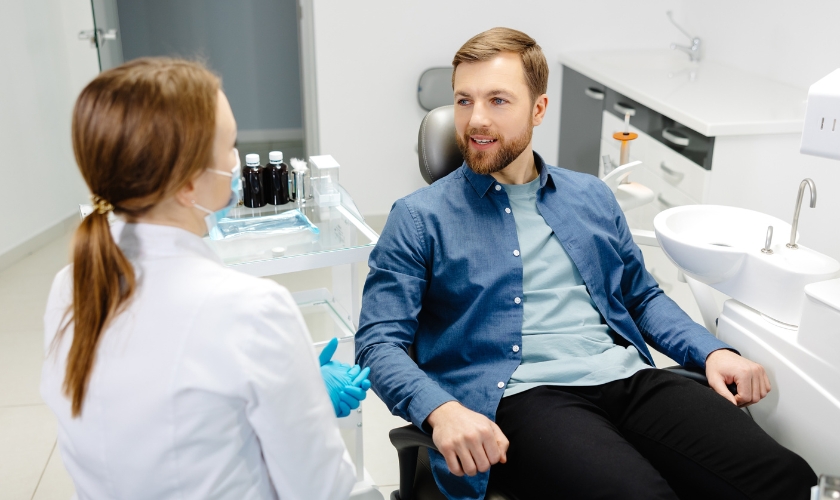
November 3, 2025
Dental Care
Taking care of your gums isn’t just about having a nice smile – it’s about keeping your whole mouth healthy. Dental treatments continue to improve, and one of the most significant advancements recently is Platelet-Rich Plasma (PRP) therapy. Dr. Jay, who’s always looking for new ways to help his patients, uses PRP therapy in his periodontal treatments to speed up healing and cut down on problems after procedures.
So, what’s PRP therapy all about?
PRP uses a highly concentrated dose of platelets from your own blood to jump-start healing and rebuild tissue. In periodontal care, Dr. Jay applies PRP right where your gums or bone are damaged or inflamed. Those platelets pack growth factors that wake up your body’s repair system, calm inflammation, and help you bounce back faster. Because it’s minimally invasive and uses your own blood, PRP has caught on fast in dental offices.
Here’s how Dr. Jay uses PRP in periodontal treatments, whether he’s treating gum disease or making bone grafts more successful:
First, he draws a little blood from your arm – just like a regular blood test. The blood is placed into a centrifuge, which spins it rapidly to separate the platelets. What you end up with is a concentrated plasma that’s ready to help your gums or jaw heal. Dr. Jay then applies this PRP right where it’s needed, encouraging new tissue growth – even for patients with pretty serious gum problems. After the treatment, your body’s own healing power is boosted, allowing you to recover more quickly and with fewer complications.
Why do many patients choose PRP therapy to enhance their gum health?
Honestly, PRP Therapy works, and it comes with a bunch of perks:
- You heal faster. The growth factors in PRP help your body recover from gum grafts, bone regeneration, and other procedures in less time.
- It’s all-natural. Since PRP comes from your own blood, there’s hardly any risk of allergic reactions or your body rejecting it.
- It’s gentle. PRP integrates seamlessly into existing treatments, eliminating the need for additional cuts or surgeries, resulting in a smoother recovery.
- It dials down inflammation. That’s a big deal if you’re fighting gum disease and want to keep your gums healthy long-term.
When it comes to treating complicated cases of gum disease, PRP therapy can make a real difference. If your gums are badly inflamed or starting to pull away from your teeth, PRP can help rebuild lost tissue and encourage bone growth. Applying PRP during treatment also reduces swelling and creates a more favorable environment for procedures such as dental implants and bone grafts to take hold.
Most people bounce back quickly after PRP therapy. You may experience some mild swelling or discomfort, but it typically resolves quickly. Since PRP uses your own blood, the odds of complications are low. Dr. Jay will provide you with clear aftercare instructions—what to eat, how to maintain oral hygiene, and when to return for a follow-up—so you stay on track for a healthy recovery.
Here’s a quick rundown of why PRP therapy is a smart choice in periodontal care:
- Speeds up tissue healing
- Helps treat advanced gum disease
- Boosts the success of dental implants and bone grafts
- Reduces inflammation and recovery time
- Very low risk, since it’s your own blood
If you’re looking for a new way to tackle gum disease, thinking about dental implants, or just want to heal faster after dental work, PRP therapy could be what you need. Dr. Jay’s approach puts you at the center, using the latest breakthroughs to get your gums and mouth back in shape.
Frequently Asked Questions (FAQs)
What is Platelet-Rich Plasma (PRP) therapy?
PRP therapy involves using a concentrated platelet-rich plasma (PRP) from your own blood to promote faster healing and tissue regeneration in areas of injury or damage.
Is PRP therapy safe for everyone?
Since PRP therapy uses your own blood, the risk of allergic reactions is minimal, making it a safe treatment for most patients. Dr. Jay will assess your health to determine if PRP is right for you.
How long does recovery take after PRP therapy?
Most patients experience mild swelling and discomfort for a few days. Full recovery typically occurs within 1 to 2 weeks, depending on the procedure and the patient’s healing speed.
Can PRP therapy help with bone regeneration?
Yes, PRP therapy is effective in promoting bone regeneration, particularly when used in conjunction with bone grafts or dental implants.
Is PRP therapy covered by insurance?
Insurance coverage for PRP therapy varies, so it’s best to check with your provider to understand your benefits. Dr. Jay’s office can assist you with insurance inquiries.
Recent Posts

How Dr. Jay Uses Platelet‑Rich Plasma in Periodontal Care

The Secret to Zero Cavities: Maximizing the Preventive Power of Your “Use-It-or-Lose-It Policy Benefits

What to Expect from Your Dental Implant Healing Process

Dentistry in Vernon: Why Your Mouth is the Window to Your Whole Body

